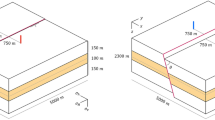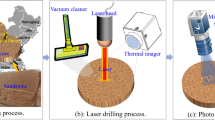We have used a numerical simulation to study the temperature distribution, thermal stress, and thermal displacements during in-situ heating of shales. We have observed that the heater temperature and the temperature at the position of the casing do not change much, while the water temperature in the wellbore and in the region of the cement ring drops quickly. The temperature in layers below the wellbore reach the melting point of the shale after continuous heating for 10-100 hours, while it reaches the heater temperature after 1000 hours. The heating efficiency drops rapidly because of significant convection, which does not permit effective heating of the strata. At the same time, thermal expansion leads to a change in the displacement in the X direction and the equivalent stress. Both the indicated parameters reach a maximum on the well wall and remain unchanged as the distance from the borehole increases. Under these conditions, the casing – cement ring interface and the cement ring – stratum interface slip considerably, separating the two interfaces, and the equivalent stress leads to yield of the casing, the cement ring, and the stratum. The results obtained can be useful for cementing and completion of wells.









Similar content being viewed by others
References
E. R. Rangel-German, J. Schembre, C. Sandberg, and A. R. Kovscek, “Electrical-heating-assisted recovery for heavy oil,” Journal of Petroleum Science and Engineering, 45, 213-231 (2004).
G. Espinosa-Paredes, A. Morales-Diaz, U. Olea-Gonzalez, and J. J. Ambriz-Garcia, “Application of a proportional-integral control for the estimation of static formation temperatures in oil wells,” Marine and Petroleum Geology, 26, 259-268 (2009).
Gilles Aouizerate, Louis J. Durlofsky, and Pierre Samier, “New models for heater wells in subsurface simulations, with application to the in situ upgrading of oil shale,” Computation Geoscience, 16, No. 2, 519-533 (2012).
A. K. Burnham, R. L. Day, M. P. Hardy, and P. H. Wallman, “AMSO’s novel approach to in-situ oil shale recovery,” in: Oil Shale: A Solution to the Liquid Fuel Dilemma, American Chemical Society, Washington (2009); Vol. 1032, pp. 149-160.
Raul Rodriguez, Jose Luis Bashbush, and Adafel Rincon, “Electrical downhole heaters for Faja heavy-oil reservoirs,” Journal of Petroleum Technology, 61, No. 3, 77-79 (2009).
S. Gasbarri, A. Diaz, and M. Guzman, “Evaluation of electric heating on recovery factors in extra heavy oil reservoirs,” in: SPE International Heavy Oil Conference and Exhibition 2011, Kuwait City, Kuwait, 12-14 December 2011; SPE 149779.
Guangchao Chen, “Research and application of electrical heating technology for well testing in high pour-point oil wells,” Well Testing, 19, No. 1, 72-74 (2010).
Zhiqin Kang, “The pyrolysis characteristics and in-situ hot drive simulation research that exploit oil-gas of oil shale,” Taiyuan University of Technology (2008).
Zhi-qin Kang, Zhao-xing Lu, Dong Yang et al., “The solid-fluid-thermal-chemistry coupling mathematical model for oil shale in-situ steam injecting development,” Journal of Xi’an Shiyou University (Natural Science Edition), 23, No. 4, 30-34 (2008).
Zhiqin Kang, Yangsheng Zhao, and Dong Yang, “Physical principle and numerical analysis of oil shale development using in-situ conversion process technology,” Acta Petrolei Sinica, 29, No. 4, 592-595 (2008).
Renling Peng, Yisu Kang, Xuan Zha et al., “Improvements of hollow rod electrically heated oil recovery technology,” Petroleum Geology and Engineering, 21, No. 1, 93-94 (2007).
Shengpeng Wang, Dexun Liu, Hongyan Wang et al., “Current situation and development potential of electric heating process of in-situ oil shale conversion,” Natural Gas Industry, 31, No. 2, 114-118 (2011).
Dong Yang, Jing Zhao, Zhiqin Kang, and Yangsheng Zhao, “Technology and numerical analysis of insitu electrical heating on oil shale,” Journal of Liaoning Technical University (Natural Science), 33, No. 2, 63-68 (2009).
Author information
Authors and Affiliations
Corresponding author
Additional information
Translated from Khimiya i Tekhnologiya Topliv i Masel, No. 6, pp. 90 – 95, November – December, 2015.
Rights and permissions
About this article
Cite this article
Hao, Y. Temperature Distribution, Thermal Stress, and Thermal Displacements During In-Situ Heating of Oil Shales. Chem Technol Fuels Oils 51, 695–708 (2016). https://doi.org/10.1007/s10553-016-0660-y
Published:
Issue Date:
DOI: https://doi.org/10.1007/s10553-016-0660-y




